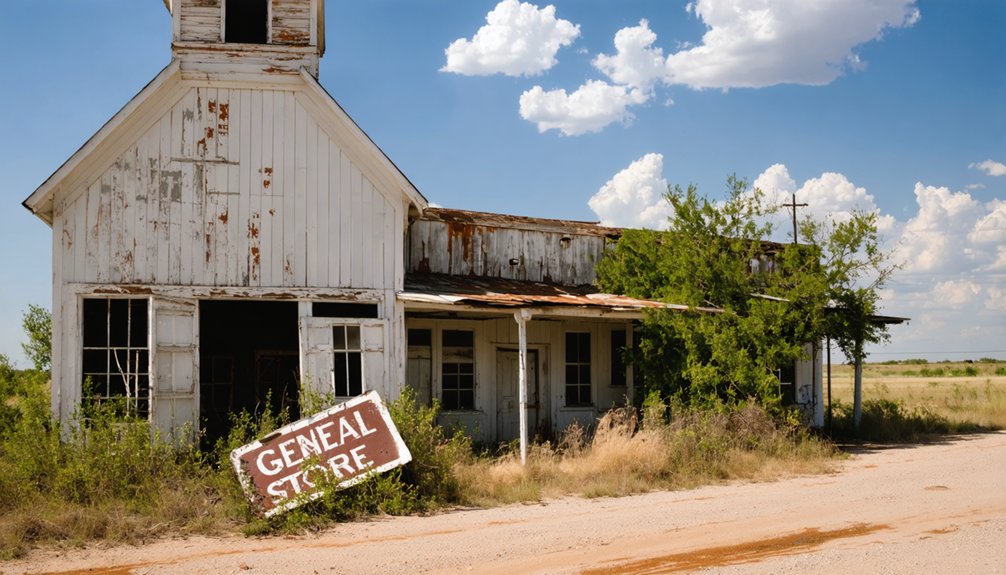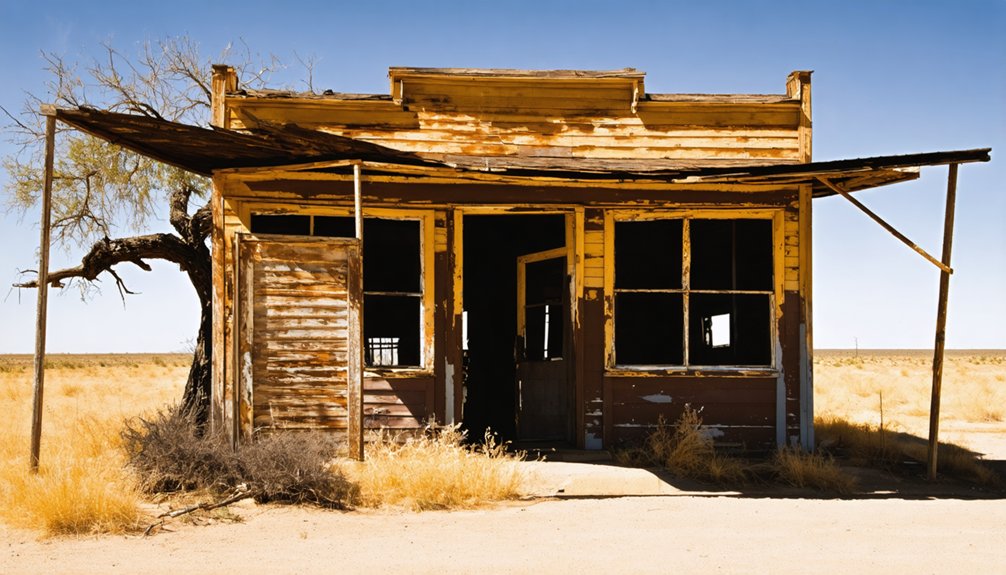You’ll find Hale City’s ghost town remnants in Hale County, Texas, where ambitious pioneers established a settlement in 1891. Despite early promise with the Hale City Missionary Baptist Church and Horatio Graves’ homestead serving as a community hub, severe drought and missed railroad connections doomed the town. By 1893, residents had abandoned Hale City for the neighboring settlement of Hale Center, leaving behind a cautionary tale of frontier dreams that reveals deeper insights into Texas’ pioneering era.
Key Takeaways
- Hale City, Texas was established in 1891 but became a ghost town by 1893 after being bypassed by railroads in favor of Hale Center.
- Severe drought in the early 1890s devastated crops and livestock, forcing many residents to abandon their properties and seek better opportunities.
- The town originated from Horatio Graves’ settlement in 1883, initially known as Epworth, serving as an early hub for mail and community services.
- Economic isolation due to lack of railroad access led to the town’s rapid decline and eventual merger with neighboring Hale Center in 1893.
- Few physical remnants of Hale City remain today, with most structures destroyed or buried beneath subsequent development in Hale County.
The Birth of a Frontier Town (1891)
The birth of Hale City in 1891 marked an ambitious but short-lived attempt at frontier settlement in central Hale County, Texas. You’ll find it was established northwest of present-day Hale Center, near Plainview, reflecting the community aspirations of pioneers seeking to build a thriving trade center on the high plains of the Llano Estacado.
Hale City’s 1891 founding embodied frontier dreams, as pioneers staked their hopes on the windswept plains of West Texas.
Despite the harsh semi-arid environment, founding residents demonstrated remarkable social cohesion through the establishment of the Hale City Missionary Baptist Church and various townsite company events. Like the Running Water Townsite development, the community held gatherings to promote settlement and sell town lots.
In 1893, the two rival settlements merged to form a new community that would receive a central location post office.
They weren’t alone in their frontier ambitions – a rival community called Epworth emerged the same year, creating competition for precious resources and railroad favor.
Both towns showcased the determination of settlers to carve out civilization in West Texas’s challenging landscape.
Early Settlement and Community Formation
Pioneering Methodist minister Horatio Graves set the foundation for Hale County’s development when he arrived in 1883, purchasing four sections of land and establishing himself as the area’s first permanent settler.
Within two years, other settlers like A.E. Adams and the Lester families joined him, creating the beginnings of a frontier community. Early settler experiences centered around Graves’ home, which served as a hub for mail delivery, church services, and schooling. The establishment of a mail route by Graves helped connect the isolated settlement to the outside world. The area was initially known as Epworth, marking the first settlement in the county with its post office established in 1884.
- Settlers built sod homes and dugouts, adapting to the harsh frontier conditions.
- Community gatherings took place in private homes before formal buildings existed.
- Z.T. Maxwell’s 1886 homestead near two hackberry groves became Plainview’s nucleus.
Environmental Challenges and Agricultural Struggles
You’ll find that Hale City’s ultimate demise began with a devastating drought in the early 1890s, which drove settlers away as crops withered and livestock struggled to survive in the harsh conditions.
Modern cities also face environmental and economic hardship, with rising food costs devastating agricultural communities and driving residents away.
The town’s semi-arid climate and lack of reliable water access made farming ventures increasingly difficult, with frequent crop failures undermining the community’s economic foundation.
The absence of proper irrigation infrastructure, combined with poor soil moisture retention, left farmers particularly vulnerable to the region’s environmental challenges, accelerating the exodus of residents to better-resourced settlements like Hale Center. Similar to modern cases like Frost and Dawson where downtown appears abandoned, the harsh environmental conditions ultimately led to widespread property abandonment.
Devastating Drought Effects
During the late 19th century, devastating drought conditions wreaked havoc on Hale City’s agricultural foundation, ultimately leading to the town’s abandonment in 1893.
Without effective drought resilience strategies, you’d have witnessed the rapid decline of this once-promising settlement as historical climate patterns devastated local farming and ranching operations.
Located in the heart of Hale County, Texas, the town faced particularly harsh conditions due to its exposed position on the South Plains.
- Severe water scarcity decimated staple crop yields and compromised livestock survival
- Widespread crop failures crippled farm incomes and disrupted essential trade networks
- Soil degradation and diminished grazing lands forced ranchers to abandon their operations
- Dryland farming proved unsustainable without adequate rainfall or irrigation infrastructure
The environmental strain triggered a mass exodus of settlers seeking more fertile ground, culminating in Hale City’s merger with Epworth in 1891 before its final abandonment.
This collapse exemplifies the harsh realities of frontier settlements attempting to survive without reliable water resources.
Water Access Problems
While the Ogallala aquifer provided Hale County’s primary water source, persistent access problems plagued both municipal systems and agricultural operations.
You’ll find small water systems serving populations under 7,500 particularly vulnerable, with towns like Hale Center and Petersburg relying on single water sources. This water scarcity threatens community resilience, especially when cybersecurity attacks target these already fragile systems. The managed depletion of the Ogallala Aquifer compounds these vulnerabilities, threatening long-term sustainability. Recent Russian hacktivist attacks on local water infrastructure have heightened concerns about system security.
The region’s challenges stem from its unique hydrology, with water-bearing formations in the Ogallala and Cretaceous limestone layers offering only moderate capacity.
You’re seeing increasing competition between agricultural and municipal demands, with projections showing urban needs surpassing farming use by 2060. Local farmers now struggle to maintain operations as rising water prices and reduced supplies strain their ability to irrigate crops and sustain livestock.
Failed Farming Ventures
Despite Hale County’s particularly fertile soil, early farming ventures in the region faced devastating setbacks that ultimately contributed to Hale City’s downfall.
You’ll find that even the most determined settlers couldn’t overcome the perfect storm of environmental and economic challenges that plagued their farming efforts in the 1890s.
- Severe droughts combined with grasshopper infestations destroyed crops, leading to widespread farming failures.
- High land costs and 5% interest rates strained farmers who were already struggling with poor market access.
- Single-section land allotments proved too small for sustainable cattle operations.
- Natural rainfall-dependent dry farming techniques weren’t sufficient to maintain consistent crop yields.
These crop challenges forced many settlers to abandon their farms, contributing to the community’s decline until technological advances and better land policies emerged after 1900.
The detailed documentation of these agricultural struggles comes from community contributions that helped preserve this important chapter of Texas history.
The Critical Railroad Connection That Never Came

You’ll find Hale City’s downfall firmly rooted in its failed railroad ambitions of 1891, when competing rail companies chose alternative routes and bypassed the fledgling settlement entirely.
Without essential rail connections, the town’s farmers and merchants couldn’t efficiently transport goods to broader markets, creating severe economic isolation that crippled growth potential.
The transportation void proved fatal within just two years, as residents and businesses relocated to more strategically positioned settlements that offered the crucial rail access needed for prosperity in late 19th-century Texas.
Bypassed By Rail Routes
As Texas towns sprouted across the frontier in the early 1900s, railroad access became the vital lifeline determining their survival.
You’ll find Hale City’s story particularly telling – its hopes were dashed when rail routes bypassed the settlement in favor of neighboring Hale Center, just two miles away.
While other towns celebrated the arrival of steam engines with barbecues and prosperity, Hale City withered without this essential connection.
- Santa Fe Railway’s route from Plainview to Floydada deliberately skipped Hale City
- Economic and geographic factors influenced railway trajectories, leaving some towns isolated
- By 1893, Hale City’s residents had abandoned their homes, moving to rail-connected Hale Center
- The railroad’s bypass effectively sealed Hale City’s fate, transforming it into another Texas ghost town
Economic Isolation Takes Hold
While Hale City’s initial promise drew settlers to the Texas frontier, the critical absence of railroad connections in the 1890s triggered a devastating economic isolation.
You’ll find that without rail integration, the town couldn’t attract essential commercial investment or establish competitive agricultural markets, leading to severe economic stagnation. Major railroads like the Texas Central and Santa Fe chose routes through neighboring towns, bypassing Hale City due to challenging terrain and costly river crossings.
The resulting trade deficits crippled local growth as farmers struggled to export their crops efficiently.
You couldn’t overlook the stark contrast between Hale City and rail-served West Texas towns that flourished as regional hubs. The isolation forced residents to rely on slow stagecoach routes for mail and goods, while increasing transportation costs ultimately strangled the town’s economic potential.
Transportation Dreams Die Fast
The ambitious dreams of Hale City’s founders crashed against harsh reality when their anticipated railroad connection never materialized.
You’d find this devastating blow struck at the heart of the town’s economic opportunities, as the Santa Fe Railroad chose to build through other locations instead. By 1910, crucial transportation routes bypassed Hale City completely, connecting rival towns like Plainview, Lockney, and Floydada to lucrative markets.
- Without rail access, you couldn’t ship agricultural goods efficiently to broader markets
- Your town missed out on the depot-centered commerce that sustained other Texas communities
- You’d watch helplessly as neighboring towns with rail service attracted settlers and investment
- The isolation forced residents to eventually relocate buildings to better-connected Hale Center
Economic Decline and Population Exodus

Dramatic shifts in oil and gas market conditions triggered a devastating economic downturn in Hale City, where over-reliance on energy sector employment left the community vulnerable to industry volatility.
The town’s economic vulnerability became starkly apparent as oil companies scaled back operations, leading to massive job losses and plummeting property values.
Economic fallout hit hard as energy companies retreated, devastating local jobs and sending housing prices into freefall.
You’ll find stark demographic shifts throughout the region, with young residents fleeing in search of better opportunities. Home prices have crashed by over 40%, while rental vacancies soar past 20%.
The exodus has created a self-reinforcing cycle: as people leave, tax revenues shrink, causing deteriorating public services that prompt even more departures.
With limited economic diversification and few prospects beyond the energy sector, Hale City’s population continues to dwindle, leaving aging residents in an increasingly hollow community.
Impact of Neighboring Town Development
As neighboring Hale Center emerged from the 1893 merger between Hale City and Epworth, a decisive shift in regional development sealed Hale City’s fate.
You’ll find that economic competition from neighboring towns quickly intensified as Hale Center became the focal point for infrastructure, commerce, and population growth. The relocation of buildings and residents to Hale Center created a new hub of activity that drew resources away from Hale City’s former prominence.
- Railroad development favored Hale Center, providing essential transportation links that Hale City lacked.
- Agricultural investments and infrastructure concentrated around Hale Center’s growing economy.
- The merger optimized regional resources by consolidating services and population in one location.
- Hale Center’s superior connectivity through emerging transport routes attracted businesses and farmers.
Legacy in Hale County History

Today, Hale City’s brief existence endures as a poignant chapter in Hale County’s development story. As one of Texas’s ghost towns, it represents the challenging realities early settlers faced when establishing communities in West Texas.
While you won’t find much physical evidence of Hale City now, its merger with Epworth to form Hale Center demonstrates the community resilience that characterized frontier settlements.
The resilient spirit of frontier towns lives on through Hale City’s legacy, even as its physical traces fade into Texas history.
The town’s historical significance extends beyond its short life, illustrating how railroad access and environmental conditions shaped the destiny of early Texas settlements.
Though Hale City didn’t survive independently, it contributed to the broader narrative of Hale County’s growth, which saw remarkable development in the early 1900s.
The county’s progression from modest beginnings to significant agricultural prominence reflects the determination that helped transform the Texas frontier.
Archaeological Remnants and Site Status Today
While archaeological discoveries near Hale City have revealed significant prehistoric activity, including the famous Plainview point site with its 9,000-year-old bison remains, physical remnants of the town itself are remarkably scarce.
Today, you’ll find the site’s archaeological significance largely overshadowed by its incorporation into modern Hale Center. Preservation efforts are minimal, with most original structures either destroyed or buried beneath newer development.
- The site’s coordinates (34°05′34″N 101°52′20″W) mark a location where foundations and footings are now difficult to locate
- Most buildings have deteriorated to roofless ruins or rubble
- The ghost town status means there’s no active population maintaining historic structures
- Unlike the well-documented Plainview point discoveries, Hale City’s remnants attract limited archaeological interest
Lessons From a Lost Settlement
The tragic demise of Hale City in the early 1890s offers crucial lessons about frontier settlement vulnerabilities in late 19th-century Texas.
You’ll find that community resilience often hinged on securing essential transportation links, particularly railroads, which could make or break a town’s survival. When Hale City failed to attract rail connections, it couldn’t overcome the mounting frontier challenges of severe drought, grasshopper plagues, and limited market access.
The settlement’s eventual merger with Epworth to form Hale Center demonstrates how frontier communities had to adapt or perish.
You can see how transportation infrastructure, environmental conditions, and economic sustainability formed a critical trinity for town survival. Those who couldn’t secure these elements often faced abandonment, while communities that pooled resources and attracted development had better chances of persisting through hardship.
Frequently Asked Questions
Were There Any Notable Crimes or Law Enforcement Incidents in Hale City?
You won’t find documented crime history or law enforcement incidents from Hale City’s brief existence. The town’s rapid decline and merger with Epworth in 1891 left no recorded notable criminal events.
What Was the Maximum Population Ever Recorded in Hale City?
Ever wonder about those vanished frontier dreams? You won’t find any official maximum population records for Hale City, though historical evidence suggests it didn’t exceed a few hundred residents during its brief 1891-1893 existence.
Did Any Famous Historical Figures Ever Visit or Stay in Hale City?
You won’t find any records of famous visitors or historically significant figures staying in Hale City. Available documentation shows no evidence of notable personalities ever visiting during its brief two-year existence.
What Was the Average Land Price per Acre in Hale City?
You won’t find exact historical land sales records, but regional land value trends suggest prices ranged from $1-10 per acre, likely on the lower end due to drought and no railroad access.
Were There Any Native American Settlements Near Hale City Before Its Establishment?
While Comanche bands once traversed the area, you won’t find evidence of permanent Native American tribes or early settlements specifically in Hale City before its 1890s establishment as a frontier town.
References
- https://en.wikipedia.org/wiki/Hale_City
- https://kids.kiddle.co/Hale_City
- https://discovertexasoutdoors.com/places/hale-city/
- https://www.forttours.com/pages/hmhale.asp
- https://en.wikipedia.org/wiki/List_of_ghost_towns_in_Texas
- http://genealogytrails.com/tex/panhandle2/hale/history_1.html
- https://www.familysearch.org/en/wiki/Hale_County
- https://www.texasescapes.com/Counties/Hale-County-Texas.htm
- https://www.texasescapes.com/TOWNS/Hale_Center/Hale_Center_Texas.htm
- https://en.wikipedia.org/wiki/Hale_Center



